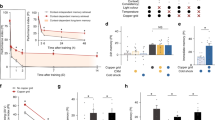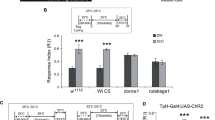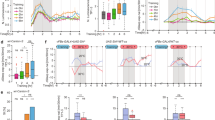Abstract
In humans and many other animals, memory consolidation occurs through multiple temporal phases and usually involves more than one neuroanatomical brain system. Genetic dissection of Pavlovian olfactory learning in Drosophila melanogaster has revealed multiple memory phases, but the predominant view holds that all memory phases occur in mushroom body neurons. Here, we demonstrate an acute requirement for NMDA receptors (NMDARs) outside of the mushroom body during long-term memory (LTM) consolidation. Targeted dsRNA-mediated silencing of Nmdar1 and Nmdar2 (also known as dNR1 or dNR2, respectively) in cholinergic R4m-subtype large-field neurons of the ellipsoid body specifically disrupted LTM consolidation, but not retrieval. Similar silencing of functional NMDARs in the mushroom body disrupted an earlier memory phase, leaving LTM intact. Our results clearly establish an anatomical site outside of the mushroom body involved with LTM consolidation, thus revealing both a distributed brain system subserving olfactory memory formation and the existence of a system-level memory consolidation in Drosophila.
This is a preview of subscription content, access via your institution
Access options
Subscribe to this journal
Receive 12 print issues and online access
$209.00 per year
only $17.42 per issue
Buy this article
- Purchase on Springer Link
- Instant access to full article PDF
Prices may be subject to local taxes which are calculated during checkout






Similar content being viewed by others
References
Xia, S. et al. NMDA receptors mediate olfactory learning and memory in Drosophila. Curr. Biol. 15, 603–615 (2005).
Roberts, A.C. & Glanzman, D.L. Learning in Aplysia: looking at synaptic plasticity from both sides. Trends Neurosci. 26, 662–670 (2003).
Tsien, J.Z. Linking Hebb's coincidence-detection to memory formation. Curr. Opin. Neurobiol. 10, 266–273 (2000).
Allweis, C. The congruity of rat and chick multiphase memory-consolidation models. In Neural and Behavioral Plasticity (ed. Andrew, R.J.) 370–393 (Oxford University Press, New York, 1991).
Davis, R.L. Olfactory memory formation in Drosophila: from molecular to systems neuroscience. Annu. Rev. Neurosci. 28, 275–302 (2005).
Margulies, C., Tully, T. & Dubnau, J. Deconstructing memory in Drosophila. Curr. Biol. 15, R700–R713 (2005).
Kogan, J.H. et al. Spaced training induces normal long-term memory in CREB mutant mice. Curr. Biol. 7, 1–11 (1997).
Tully, T., Preat, T., Boynton, S.C. & Del Vecchio, M. Genetic dissection of consolidated memory in Drosophila. Cell 79, 35–47 (1994).
Eichenbaum, H. & Cohen, N.J. From Conditioning to Conscious Recollection: Memory Systems of the Brain 583 (Oxford University Press, New York, 2001).
Gerber, B., Tanimoto, H. & Heisenberg, M. An engram found? Evaluating the evidence from fruit flies. Curr. Opin. Neurobiol. 14, 737–744 (2004).
Stocker, R.F. The organization of the chemosensory system in Drosophila melanogaster: a review. Cell Tissue Res. 275, 3–26 (1994).
Jefferis, G.S., Marin, E.C., Watts, R.J. & Luo, L. Development of neuronal connectivity in Drosophila antennal lobes and mushroom bodies. Curr. Opin. Neurobiol. 12, 80–86 (2002).
Hanesch, U., Fischback, K.-F. & Heisenberg, M. Neuronal architecture of the central complex in Drosophila melanogaster. Cell Tissue Res. 257, 343–366 (1989).
Strauss, R. & Heisenberg, M. A higher control center of locomotor behavior in the Drosophila brain. J. Neurosci. 13, 1852–1861 (1993).
Comas, D., Petit, F. & Preat, T. Drosophila long-term memory formation involves regulation of cathepsin activity. Nature 430, 460–463 (2004).
Dubnau, J. et al. The staufen/pumilio pathway is involved in Drosophila long-term memory. Curr. Biol. 13, 286–296 (2003).
Waddell, S., Armstrong, J.D., Kitamoto, T., Kaiser, K. & Quinn, W.G. The amnesiac gene product is expressed in two neurons in the Drosophila brain that are critical for memory. Cell 103, 805–813 (2000).
Pascual, A., Huang, K.L., Neveu, J. & Preat, T. Neuroanatomy: brain asymmetry and long-term memory. Nature 427, 605–606 (2004).
Kitamoto, T. Conditional modification of behavior in Drosophila by targeted expression of a temperature-sensitive shibire allele in defined neurons. J. Neurobiol. 47, 81–92 (2001).
Brand, A.H. & Perrimon, N. Targeted gene expression as a means of altering cell fates and generating dominant phenotypes. Development 118, 401–415 (1993).
Carthew, R.W. Gene silencing by double-stranded RNA. Curr. Opin. Cell Biol. 13, 244–248 (2001).
Fire, A. et al. Potent and specific genetic interference by double-stranded RNA in Caenorhabditis elegans. Nature 391, 806–811 (1998).
Hannon, G.J. RNA interference. Nature 418, 244–251 (2002).
Flockhart, I. et al. Fly RNAi: the Drosophila RNAi screening center database. Nucleic Acids Res. 34, D489–D494 (2006).
Liu, G. et al. Distinct memory traces for two visual features in the Drosophila brain. Nature 439, 551–556 (2006).
Sakai, T., Tamura, T., Kitamoto, T. & Kidokoro, Y. A clock gene, period, plays a key role in long-term memory formation in Drosophila. Proc. Natl. Acad. Sci. USA 101, 16058–16063 (2004).
Siegmund, T. & Korge, G. Innervation of the ring gland of Drosophila melanogaster. J. Comp. Neurol. 431, 481–491 (2001).
Renn, S.C. et al. Genetic analysis of the Drosophila ellipsoid body neuropil: organization and development of the central complex. J. Neurobiol. 41, 189–207 (1999).
Yin, J.C. et al. Induction of a dominant-negative CREB transgene specifically blocks long-term memory in Drosophila. Cell 79, 49–58 (1994).
McGuire, S.E., Le, P.T., Osborn, A.J., Matsumoto, K. & Davis, R.L. Spatiotemporal rescue of memory dysfunction in Drosophila. Science 302, 1765–1768 (2003).
Tang, Y.P. et al. Genetic enhancement of learning and memory in mice. Nature 401, 63–69 (1999).
Lee, T., Lee, A. & Luo, L. Development of the Drosophila mushroom bodies: sequential generation of three distinct types of neurons from a neuroblast. Development 126, 4065–4076 (1999).
Dash, P.K., Hebert, A.E. & Runyan, J.D. A unified theory for systems and cellular memory consolidation. Brain Res. Brain Res. Rev. 45, 30–37 (2004).
Isabel, G., Pascual, A. & Preat, T. Exclusive consolidated memory phases in Drosophila. Science 304, 1024–1027 (2004).
Yu, D., Keene, A.C., Srivatsan, A., Waddell, S. & Davis, R.L. Drosophila DPM neurons form a delayed and branch-specific memory trace after olfactory classical conditioning. Cell 123, 945–957 (2005).
Nakazawa, K., McHugh, T.J., Wilson, M.A. & Tonegawa, S. NMDA receptors, place cells and hippocampal spatial memory. Nat. Rev. Neurosci. 5, 361–372 (2004).
Akalal, D.B. et al. Roles for Drosophila mushroom body neurons in olfactory learning and memory. Learn. Mem. 13, 659–668 (2006).
Dubnau, J., Grady, L., Kitamoto, T. & Tully, T. Disruption of neurotransmission in Drosophila mushroom body blocks retrieval, but not acquisition, of memory. Nature 411, 476–480 (2001).
McGuire, S.E., Le, P.T. & Davis, R.L. The role of Drosophila mushroom body signaling in olfactory memory. Science 293, 1330–1333 (2001).
Krashes, M.J., Keene, A.C., Leung, B., Armstrong, J.D. & Waddell, S. Sequential use of mushroom body neuron subsets during Drosophila odor memory processing. Neuron 53, 103–115 (2007).
Dudai, Y. The neurobiology of consolidations, or, how stable is the engram? Annu. Rev. Psychol. 55, 51–86 (2004).
Frankland, P.W. & Bontempi, B. The organization of recent and remote memories. Nat. Rev. Neurosci. 6, 119–130 (2005).
Wiltgen, B.J., Brown, R.A., Talton, L.E. & Silva, A.J. New circuits for old memories: the role of the neocortex in consolidation. Neuron 44, 101–108 (2004).
Xia, S. & Tully, T. Segregation of odor identity and intensity during odor discrimination in Drosophila mushroom body. PLoS Biol. 5, e264 (2007).
Feany, M.B. & Quinn, W.G. A neuropeptide gene defined by the Drosophila memory mutant amnesiac. Science 268, 869–873 (1995).
Keene, A.C. et al. Diverse odor-conditioned memories require uniquely timed dorsal paired medial neuron output. Neuron 44, 521–533 (2004).
Emptage, N.J. & Carew, T.J. Long-term synaptic facilitation in the absence of short-term facilitation in Aplysia neurons. Science 262, 253–256 (1993).
Tully, T. & Quinn, W.G. Classical conditioning and retention in normal and mutant Drosophila melanogaster. J. Comp. Physiol. [A] 157, 263–277 (1985).
Acknowledgements
We thank G. Korge, Y. Zhong, L. Luo and Bloomington Fly Center for fly stocks. We also thank M. Heisenberg, H. Cline and J. Dubnau for comments and discussion. This work was supported by grants to T.T. from the US National Institutes of Health and Dart Neurosciences, LLC, and to A.-S.C. from the National Science Council, the Brain Research Center of the University System of Taiwan and the Technology Development Program of Ministry of Economy.
Author information
Authors and Affiliations
Contributions
C.-L.W. and S.X. conceived and designed the experiments. C.-L.W., S.X. and T.-F.F. carried out the experiments with technique support from H.W., D.L. and Y.-H.C. C.-L.W., S.X. and A.-S.C. analyzed the data. C.-L.W. and S.X. graphed the data. S.X. and T.T. wrote the paper.
Corresponding authors
Supplementary information
Supplementary Text and Figures
Supplementary Figures 1–9, Table 1 and Methods (PDF 1995 kb)
Rights and permissions
About this article
Cite this article
Wu, CL., Xia, S., Fu, TF. et al. Specific requirement of NMDA receptors for long-term memory consolidation in Drosophila ellipsoid body. Nat Neurosci 10, 1578–1586 (2007). https://doi.org/10.1038/nn2005
Received:
Accepted:
Published:
Issue Date:
DOI: https://doi.org/10.1038/nn2005
This article is cited by
-
The NMDA receptor regulates competition of epithelial cells in the Drosophila wing
Nature Communications (2020)
-
The allometry of the arcuate body in the postembryonic development of the giant house spider Eratigena atrica
Invertebrate Neuroscience (2018)
-
Neural circuits for long-term water-reward memory processing in thirsty Drosophila
Nature Communications (2017)
-
Long-term memory requires sequential protein synthesis in three subsets of mushroom body output neurons in Drosophila
Scientific Reports (2017)
-
Coupled symmetric and asymmetric circuits underlying spatial orientation in fruit flies
Nature Communications (2017)



